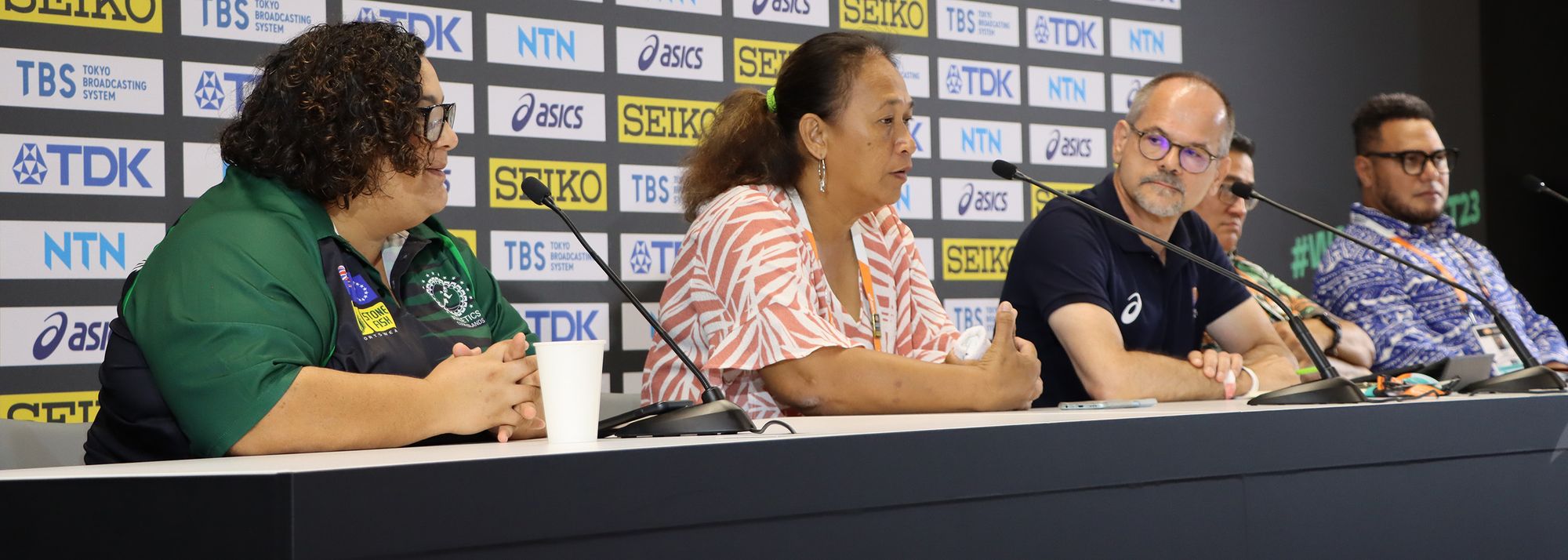Simone Fe'ao, Rusila Tekamotiata, Bob Ramsak, Jerry Brunt and Niuone Eliuta at Sport on the Climate Change Frontlines (© Matthew Quine)
When you live in a country that’s literally disappearing due to climate change, track and field athletics might seem a rather trivial matter.
But that’s not the case according to a group of sports leaders who gathered at the National Athletics Centre in Budapest on Monday (21) to discuss sport and sustainability as part of the Sport on the Climate Change Front Lines panel. Indeed, it could even be part of the answer.
Representing some of the smallest World Athletics federations from some of the most vulnerable countries on the planet, the five leaders had one stark message: “Sport can’t escape climate change but it can help do something about it.”
Presentation begins at 5:06
It’s a message they are well-placed to deliver, coming from some of the smallest sea-bound nations in the South Pacific where the few under-resourced sporting facilities often disappear under climate-induced floods or become unusable following ever increasing natural disasters, such as earthquakes and cyclones that sweep across their tiny but beautiful islands.
It’s a region where climate change has damaged crops, hampered fishing, destroyed traditional industries, and forced many young people, including athletes, to leave in pursuit of a better life and a chance to fulfil their potential.
Take Tuvalu, for example, a low-lying archipelago of nine atolls containing 11,000 people, 40% of whom are young, where the “land is gradually fading away due to coastal flooding”, according to Tuvalu Athletics’ general secretary, Niuone Eliuta.
“It is scary to live on an island at the frontline of climate change,” he said. “If things carry on the way they are going, in 50 to 100 years we may not even exist.
“Ten per cent of our population are engaged in sports, yet we don’t have a proper synthetic track. We have a grass track but there are holes all over it and when it floods the water comes up through the ground. You can almost see the fish and crabs on it.
“If we continue in this way, over the next 30 years we may not have an athletics federation or any athletes to send to world championships.
“The future of humanity really depends on what we do today, even in sports.”
The impact is similar in Kiribati, a collection of 33 coral islands spread across the equator, “some so small you can see the sea on both sides at the same time”, as Kiribati Athletics president Rusila Tekamotiata explained.
“Athletes need a place to train and as we are losing land through erosion it is becoming increasingly challenging for our athletes,” she said. “We always have to think about how the climate will affect us. It is an integral part of how we plan all our events and activities.”
The message was reiterated by Jerry Brunt, president of Samoa Athletics, whose one synthetic track is often under water due to flash floods.
“This facility is where we hold every event,” he said. “But competition is fierce from other sports. There is a grass field too but that’s often prone to flooding too.
“It has such an impact on our athletes’ ability to reach their potential. We have to send them overseas.”

Jerry Brunt, Niuone Eliuta and Antoine Boudier at Sport on the Climate Change Frontlines (© Matthew Quine)
As for what sport can do to help, the answer is neither simple nor one dimensional, as Antoine Boudier, president of Vanuatu Athletics made clear.
“Today, when we are talking about a way forward with sports and athletics in general, we’ve got a climate footprint on the one hand and we’re saying we want to save the planet.
“But we want better shoes, better equipment, better running track and fields,” he said. “It doesn’t match. We are actually talking two different languages going opposite to each other. How can we find the middle ground?
“I’m pretty sure by finding that middle ground will make a big change to the planet.
“Over the years, people have been expecting to put on better, more beautiful events, to be the best so people can remember a Games forever, but at a price. I think we need to reverse that cycle today.”
The measures already being taken by these organisations include not using plastic bottles for water, using sport to deliver programmes in schools, and persuading athletes to act as role models and ambassadors for the environment.
But as Simone Fe’ao, president of athletics in the Cook Islands, pointed out: “It's going to take more than just 20 Oceania nations to make the difference.
“For us, being sustainable as sports organisations is not about ticking a box, this is real life,” she said. “We as athletics bodies have a positive opportunity to be ambassadors for sustainability.
“It’s not about stopping climate change, but we must do what we can to slow it.”
Her call for action was backed by Bob Ramsak, head of sustainability at World Athletics.
“These countries really are on the front line of the global environmental crisis,” he said. “They’re facing literal, physical extinction if something doesn’t change.
“And it’s not their fault. They’re doing what they can, as countries and in athletics. But it needs the rest of us, including international bodies like World Athletics to do more.
“A World Athletics survey showed that 77% of athletes are very or extremely concerned about climate change. It’s a live issue for them so we must use their voices to get the message across.
“And we have to figure out a way to use our influence to de-carbonise our events.”
Matthew Brown for World Athletics




